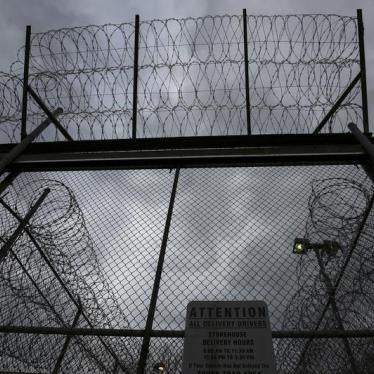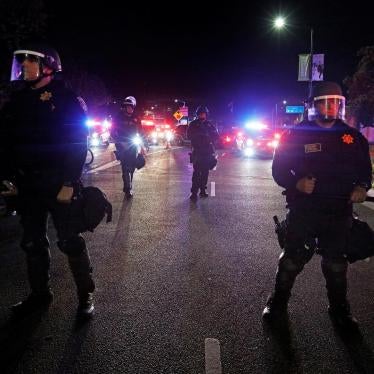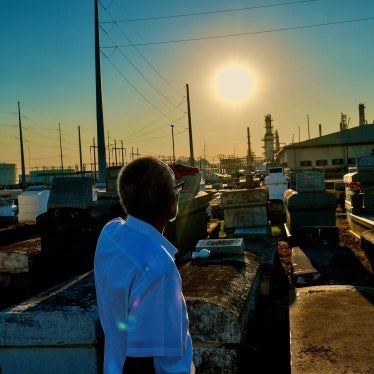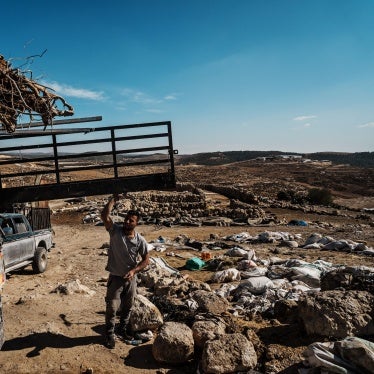Justice Marsha Slough, Chair, and all members, Pretrial Reform and Operations Workgroup
C/O Judicial Council of California 455 Golden Gate Avenue
San Francisco, CA 94102-3688
Sent by e-mail
February 10, 2020
Re: California Judicial Council Pretrial Reform and Operations Workgroup
Human Rights Watch is an international non-profit organization dedicated to investigating and reporting on human rights violations throughout the world.1 Our United States Program focuses on, among other things, human rights compliance within the criminal legal system. We have produced two major reports and many shorter pieces documenting human rights concerns raised by unwarranted pretrial incarceration in US criminal courts and recommending reforms. The reports specifically highlight the systems in New York and California.2
Our California report and my subsequent writings on the topic have unequivocally opposed any use of actuarial or algorithm-based risk assessment tools in pretrial decision-making. Implementing risk assessment tools, even as a replacement for money bail, will harm people going through our court systems, their families and their communities. It will undermine the credibility of California courts.
Before addressing the problems of risk assessment, I will address the Pretrial Reform and Operations Workgroup’s process. As an organization dedicated to promoting human rights throughout the world, we know that one of the hallmarks of a rights- respecting society that abides by democratic values is public participation in and transparency of decision-making.
When I received the invitation to speak to you at this meeting, I was eager to accept and share my research and my understanding of the subject. Then I learned that the meetings would be closed to the public, that no record would be made of what anyone said during the meetings, that we would be required to leave after our allotted time, and that we could not even know who else was speaking.
Several panelists, including myself, and other interested parties throughout the state have requested that the meeting be open and on the record. The Workgroup has denied that request.
California Rules of Court, Rule 10.75 requires Judicial Council advisory bodies to hold their meetings in public view.3 While some technical reading of the law may exempt this Workgroup, the spirit of that rule calls for openness. Your decision to close this meeting harms our democratic process.
This is not an academic point. This Workgroup’s predecessor, in what appears to have been a very similar process, released a report with a slate of recommendations that were transformed into SB10, the “reform” law that attempts to expand judicial power of preventive detention and that mandates the use of risk assessment tools.4 That process happened in secrecy with disastrous results.
An open process increases the chance of finding effective solutions that balance the needs and rights of all stakeholders.
The Harms of Pretrial Incarceration
Unnecessary use of pretrial incarceration betrays the presumption of innocence, a fundamental guiding principle of the US legal system, by keeping people in jail who have not been convicted of a crime. Human Rights Watch’s California report documented that between 2011-2015, close to half-a-million people were subject to felony arrests and held in pretrial detention or forced to pay
bail, but never found to be guilty of any crime, an unjust punishment that cost taxpayers millions of dollars.5 Poor people jailed pretrial, with bail set, face the miserable options of taking on heavy debt to pay bail, remaining in custody until their cases resolve, or pleading guilty to gain freedom sooner, regardless of actual guilt.6 The large-scale use of pretrial detention, resulting in pressured guilty pleas, causes immeasurable harm to people and damages the credibility of our criminal legal system.
Pretrial detention has traditionally been accomplished by setting money bail. Now, many courts in the US are replacing money bail with risk assessment tools.
Risk Assessment Tools are a Dangerous, Unfair Substitute
Risk assessment tools purport to estimate the statistical likelihood that a person will commit some future misconduct, like missing a court date or arrest for a new crime. They take discrete facts about the person, without providing individualized context for those facts, to create what is essentially a profile, then compare that profile to a large dataset of other people with similar profiles. They assign a likelihood of future misconduct by the person based on the percentages of successful or unsuccessful outcomes from the larger dataset.
The tools give statistical estimates of future behavior that impact a person’s freedom or imprisonment based on how other people have behaved in the past. This disregard for individual context will lead to unjust outcomes. The commonly used Arnold Ventures PSA tool scores past missed court dates against a person, but does not distinguish between, for example, a person who missed court due to being sick and came in the next day, as opposed to a person who deliberately fled the state to avoid prosecution. The same tool scores any “prior felony conviction” the same, though they can range from relatively minor theft offenses to murder.7
Courts should ground decisions in an individual’s own actions, placed in context, not in the actions of other people.
The tools do not predict future crime. To the extent they predict anything, it is future arrest. While an individual’s behavior partly determines likelihood of arrest, police behavior is a significant determining factor. People living in over-policed communities or otherwise subject to aggressive policing face higher risk of arrest for the same behavior. For example, someone who illegally possesses a firearm in a community with a low police presence will have little risk of being stopped and searched, while someone in a highly policed community will have a high risk of stop, search and arrest. Historic and current racial and class bias in policing, including discrimination by individual officers, racial profiling and biased deployment patterns, strongly influences arrest results.8
While the tools generally do not use race or economic class specifically in their formulas, they use other factors that stand as proxies, including arrest history, employment history, residential stability and education levels. This means that the profiles have a built-in bias, reflective of and amplifying the biases already existing in the criminal legal system and in US society as awhole.9 While not necessarily designed to be racist, because they rely on racially biased inputs, their outputs or recommendations will reflect that bias.10 Because of their claim to scientific objectivity, they may provide a veneer of legitimacy to that discrimination.
Risk assessment tools are often promoted as an effective mechanism to reduce pretrial incarceration, but, in fact, they can be used just as easily to increase incarceration.11 The scoring system of any risk assessment tool can be adjusted to fit more or less people into the various risk categories, thus allowing it to be manipulated to raise or lower the numbers of people released or detained.1
These inherent problems—decision-making based on non-contextual statistical predictions, racial and class bias, and subjectively adjustable scoring—are reason enough to reject use of the tools by a state seeking to implement an equitable system that respects the presumption of innocence. Additionally, the tools are not especially accurate13 and rely on secretive formulas and data that makes it difficult, if not impossible, for defendants to understand how their scores were generated in order to challenge their recommendations.14
The tools run counter to basic principles undergirding the US legal system, including that each person should be judged as an individual. International human rights law protects an individual’s right to liberty from arbitrary restriction, either through arbitrary laws or through arbitrary enforcement of the law.15 The Inter-American Commission on Human Rights has emphasized that pretrial custody decisions should not be made by reference to pre-set formulas, patterns or stereotypes, but, instead, must be grounded in reasoning that contains specific, individualized facts and circumstances justifying such detention.16
Human Rights Watch urges avoiding the use of risk assessment tools altogether. Instead, pretrial reform should honor the presumption of innocence by greatly limiting who is eligible for pretrial incarceration in the first place, and by requiring individualized hearings with rigorous evaluations of evidence, procedural requirements, and standards of proof, before a court can order incarceration.
Replacing money bail with risk assessment will not address the problems of unnecessary pretrial incarceration, will not improve the racial and class discrimination of the system, and will not result in fairer outcomes. A court system committed to justice should not use them.
1 Human Rights Watch, “About Us,” undated, https://www.hrw.org/about-us (accessed June 24, 2019).
2 Human Rights Watch, The Price of Freedom: Bail and Pretrial Detention of low Income Nonfelony Defendants in New York City, (New York: Human Rights Watch, 2010), https://www.hrw.org/report/2010/12/02/price-freedom/bail-and-pretrial- detention-low-income-nonfelony-defendants-new-york; Human Rights Watch, “Not in it for justice”: How California’s Pretrial Detention and Bail System Unfairly Punishes Poor People, (New York: Human Rights Watch, 2017), https://www.hrw.org/report/2017/04/11/not-it-justice/how-californias-pretrial-detention-and-bail-system-unfairly.
3 California Rules of Court, Rule 10.75, adopted July 1, 2014, https://www.courts.ca.gov/cms/rules/index.cfm?title=ten&linkid=rule10_75.
4 “Chief Justice Names Group to Review Pretrial Reforms in California,” California Courts Newsroom, California Courts, Judicial Branch of California, January 15, 2019, https://newsroom.courts.ca.gov/news/chief-justice-names-group-to-review-pretrial-reform-efforts-in- california (accessed February 7, 2020); John Raphling (Human Rights Watch), “California Ended Money Bail—But May Have Replaced it with Something Even Worse,” commentary, The Nation, September 24, 2018, https://www.thenation.com/article/archive/california- ended-cash-bail-but-may-have-replaced-it-with-something-even-worse/.
5 Human Rights Watch, “Not in it for Justice.”
6 In California, according to Human Rights Watch’s analysis of data from six counties, the vast majority of people released from jail as “sentenced” on low-level felonies and misdemeanors were released before the earliest possible date they could have gone to trial. In other words, to assert their innocence at trial, they would have had to stay in jail longer than they did by pleading guilty. Human Rights Watch, “Not in it for Justice,” p. 56.
7 Laura and John Arnold Foundation, “Public Safety Assessment: Risk factors and formula,” undated, https://www.psapretrial.org/about/factors (accessed February 7, 2020).
8 Elizabeth Hinton et al., “An Unjust Burden: The Disparate Treatment of Black Americans in the Criminal Justice System,” Vera Institute of Justice, May 2018, https://storage.googleapis.com/vera-web-assets/downloads/Publications/for-the-record-unjust- burden/legacy_downloads/for-the-record-unjust-burden-racial-disparities.pdf (accessed February 7, 2020). For example, nationally, white and black people use illicit drugs at roughly equal rates, but police arrest black people at substantially higher rates for these offenses. Human Rights Watch, Every 25 Seconds: The Human Toll of Criminalizing Drug Use in the United States, (New York: Human Rights Watch, 2016), https://www.hrw.org/report/2016/10/12/every-25-seconds/human-toll-criminalizing-drug-use-united-states.
9 Elizabeth Hinton et al., “An Unjust Burden: The Disparate Treatment of Black Americans in the Criminal Justice System,” Vera Institute of Justice, May 2018, https://storage.googleapis.com/vera-web-assets/downloads/Publications/for-the-record-unjust- burden/legacy_downloads/for-the-record-unjust-burden-racial-disparities.pdf (accessed February 7, 2020).
10 Laurel Eckhouse, “Big data may be reinforcing racial bias in the criminal justice system,” Washington Post, February 10, 2017, https://www.washingtonpost.com/opinions/big-data-may-be-reinforcing-racial-bias-in-the-criminal-justice- system/2017/02/10/d63de518-ee3a-11e6-9973-c5efb7ccfb0d_story.html?utm_term=.0bd98097310d (accessed February 7, 2020).
11 While New Jersey, which used the tools as part of a comprehensive set of recent pretrial reforms, has had significant reduction in pretrial incarceration rates, Kentucky, which also uses the tools, has not. New Jersey Judiciary, “2017 Report to the Governor and the Legislature,” February 2018, https://www.judiciary.state.nj.us/courts/assets/criminal/2017cjrannual.pdf (accessed February 7, 2020); Megan Stevenson, “Assessing Risk Assessment in Action,” 103 Minnesota Law Review 303 (2018), accessed February 7, 2020, http://dx.doi.org/10.2139/ssrn.3016088. In Lucas County, Ohio, implementation of the Arnold tool increased the rate of pretrial detention and increased the percentage of people pleading guilty on their first court appearance. Human Rights Watch, “Not in it for Justice,” p. 91.
12 Santa Cruz County in California adjusted its tool’s “decision making framework” and doubled the number of people assigned to release with supervision. Santa Cruz County Probation Department, “Alternatives to Custody Report 2015,” April 2016, file:///C:/Users/raphlij/Downloads/Snapshot-5956.pdf (accessed February 7, 2020), p. 11; Human Rights Watch, “Not in it for Justice,” pp. 99-100.
13 Julia Angwin et al., “Machine Bias,” ProPublica, May 23, 2016, https://www.propublica.org/article/machine-bias-risk-assessments- in-criminal-sentencing (accessed February 7, 2020); Rowan Walrath, “Software Used to Make ‘Life-Altering’ Decisions Is No Better Than Random People at Predicting Recidivism,” Mother Jones, January 17, 2018, https://www.motherjones.com/crime- justice/2018/01/compas-software-racial-bias-inaccurate-predicting-recidivism/ (accessed February 7, 2020).
![]() 14 The Arnold tool has some degree of transparency about the factors it considers and how they are weighted. See Laura and John Arnold Foundation, “Public Safety Assessment: Risk factors and formula,” https://www.psapretrial.org/about/factors (accessed February 7, 2020). However, Arnold has been criticized for not revealing how it developed its algorithms, why it used the data it chose to develop the system, whether it performed validation, and, if it did, what the outcomes were. John Logan Koepke and David G. Robinson, “Danger Ahead: Risk Assessment and the Future of Bail Reform,” Washington Law Review Vol. 93 (2018): 1803, accessed February 7, 2020, http://digital.law.washington.edu/dspace-law/bitstream/handle/1773.1/1849/93WLR1725.pdf.
14 The Arnold tool has some degree of transparency about the factors it considers and how they are weighted. See Laura and John Arnold Foundation, “Public Safety Assessment: Risk factors and formula,” https://www.psapretrial.org/about/factors (accessed February 7, 2020). However, Arnold has been criticized for not revealing how it developed its algorithms, why it used the data it chose to develop the system, whether it performed validation, and, if it did, what the outcomes were. John Logan Koepke and David G. Robinson, “Danger Ahead: Risk Assessment and the Future of Bail Reform,” Washington Law Review Vol. 93 (2018): 1803, accessed February 7, 2020, http://digital.law.washington.edu/dspace-law/bitstream/handle/1773.1/1849/93WLR1725.pdf.
15 International Covenant on Civil and Political Rights (ICCPR), G.A. res. 2200A (XXI), 21 U.N. GAOR Supp. (No. 16) at 52, U.N. Doc. A/6316 (1966), 999 U.N.T.S. 171, entered into force Mar. 23, 1976, article 9(1), https://treaties.un.org/doc/publication/unts/volume%20999/volume-999-i-14668-english.pdf (accessed February 7, 2020). The US ratified the ICCPR in 1992. Under ICCPR article 50, “[t]he provisions of the present Covenant shall extend to all parts of federal States without any limitations or exceptions.”
16 Inter-American Commission on Human Rights, Report on the Use of Pretrial Detention in the Americas, OEA/Ser.L/V/VII, Doc. 46/13 (2013), https://www.oas.org/en/iachr/pdl/reports/pdfs/Report-PD-2013-en.pdf (accessed February 7, 2020). The United States has signed, but not ratified, the American Convention, and as such is not legally bound by its provisions. However, the Inter-American Commission’s guidance is a useful and authoritative guide to the protection of fundamental human rights. This is particularly true in this area, because the American Convention’s due process guarantees are in many respects similar to those guaranteed under US law and by international instruments binding on the United States.







